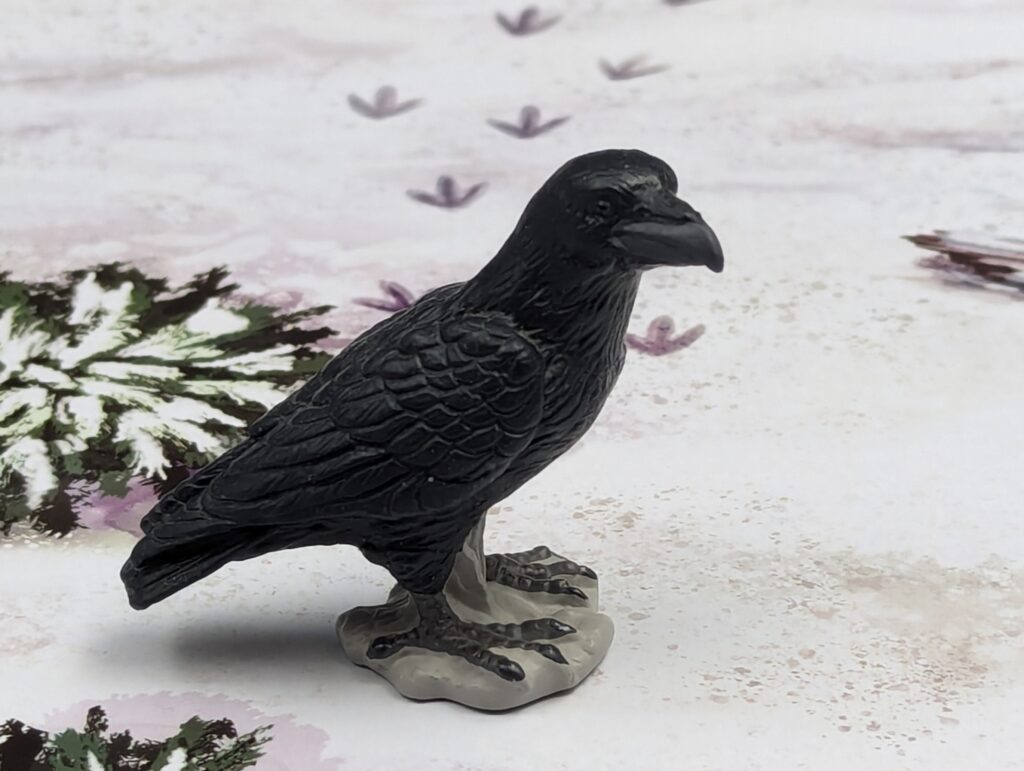
Happy Halloween! I got the special date this year, so I’m bringing you thrills and chills…in the form of the Schleich common raven, Corvus corax, item number 14241. The way ravens are closely tied to all things sinister and spooky was already well-covered a few years ago, an animal well-established throughout the northern hemisphere. Their haunting calls, their fondness for carrion and mobbing weak prey, their spooky (I think it’s neat) calls. And probably their all-black colour that just screams ‘night time terror’ even though their more diurnal. Anyway…there is a great deal of genetic variation and many subspecies, but most likely this one is meant to represent the north Eurasian common raven, Corvus corax corax. This is mainly likely since Schleich often produced animals most representative from Germany–it was released in 2001, before Schleich truly exploded across the figure market and revisited their production strategies so many times! That’s why the series for the figure is kind of confusing–at one point the various lines were divided by nebulous ‘habitats’ like Forest Life (mostly Europe and North America but only forest dwellers); more recently Schleich uses regional distributions; most of the figures were retconned into those lines at some point, and the raven was included with the Europe series (although their range is well beyond that).
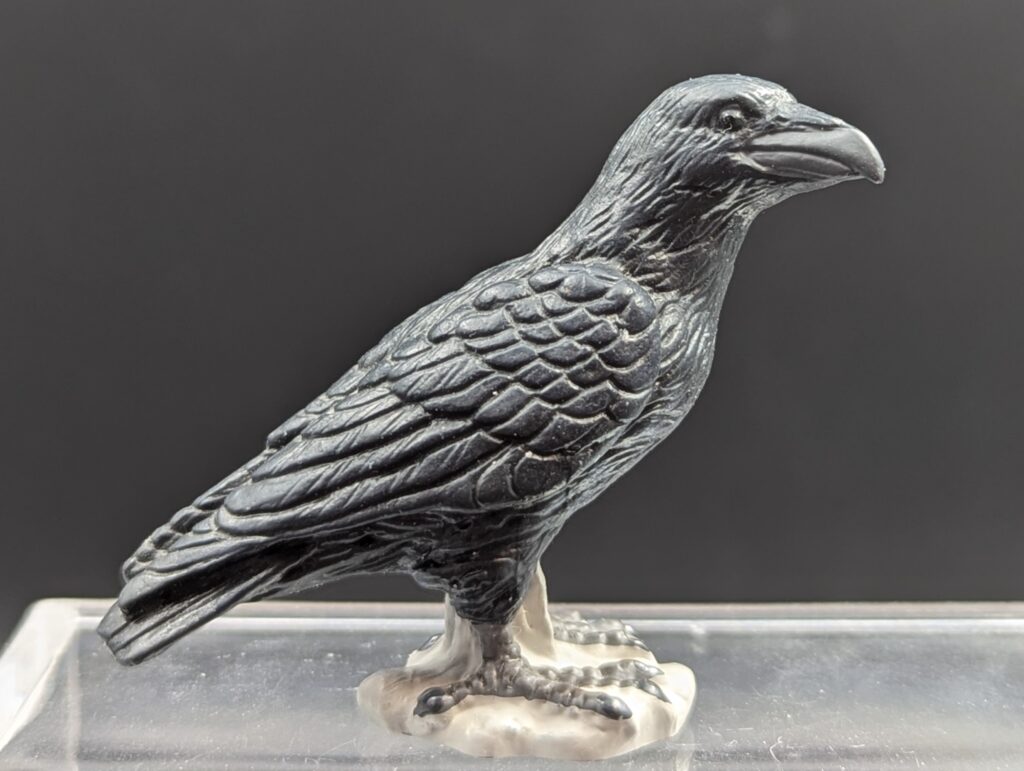
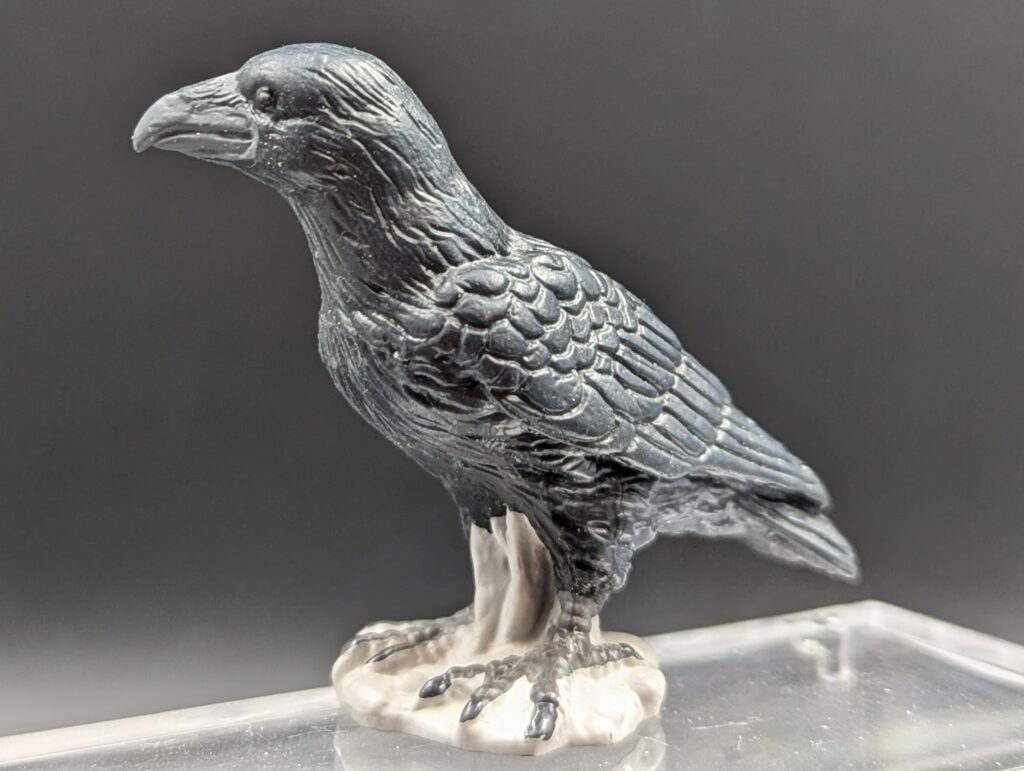
That earlier post also discussed the life history of the common raven, so again I have little to add. These are very intelligent, opportunistic and adaptive birds. They can be foragers, predators, omnivores, or any and all of these things. Ravens can be social but quarrelsome, but generally travel in mated pairs. In terms of habitat, they also vary widely in climate and geography. Ravens can be found on tundra and in deserts, in mountains and on islands, inland or in coastal regions; in some northern areas they migrate annually, while in other places they remain year round. Their preferred habitat in much of their range is wooded areas with access to open ranges or coasts. Overall, ravens are adept at adapting to changing environments affected by humans, taking advantage of increased food opportunities. From experience, I only see them in the local foothills an mountains, while crows and magpies tend to fill the more inhabited areas. Their ability to thrive in the face of encroachment is probably why the IUCN lists the species as Least Concern–it’s definitely a species with the intelligence to adapt and expand in the face of human interference!


The figure itself is positioned in a standing upright pose, with wings tightly folded against the tail, on a grey base with grey material up between the legs. This gives stability, but is kind of awkward. Also, oddly, a similar basing was used for the Safari figure (but at least the space in the legs was kept clear). I’m just going to say, it is a slight distraction and detriment to the figure. Anyway, the figure itself is very carefully sculpted. The length of the figure from bill to tail is about 8.2cm long–given an average of about 63cm long, that puts the figure at about 1:8, pretty much in line with the Safari one.
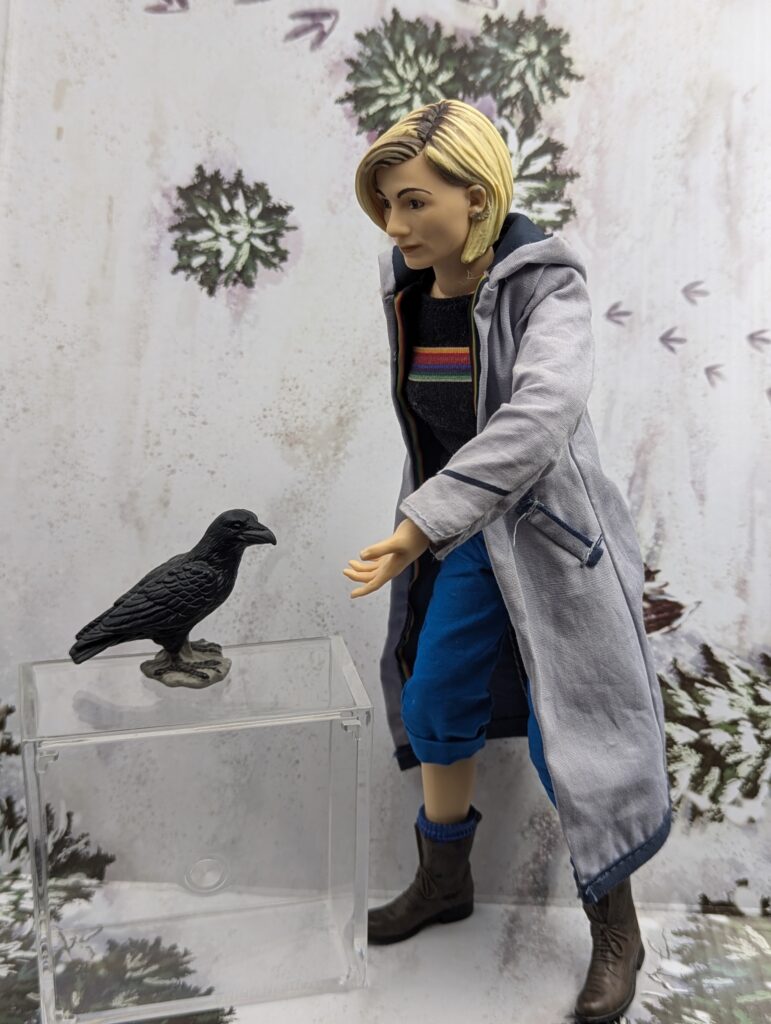
The feathering is detailed, but quite flat, lacking the ruff of feathers around the neck/throat. There is a lot of successful differentiation of the feathers along the body, with small finer ones around the shoulders and chest, and increasingly longer overlapping feathers along the wing. The tail is tucked against the folded wing tips and protrudes further out, squared off with rounded corners. In flight, a raven would have an expanded, wedge-shaped tail with an extended medial post–but it doesn’t look like this in a resting position. Which, again, means a flying or ruffed up figure would be an interesting an unique way to present the species.
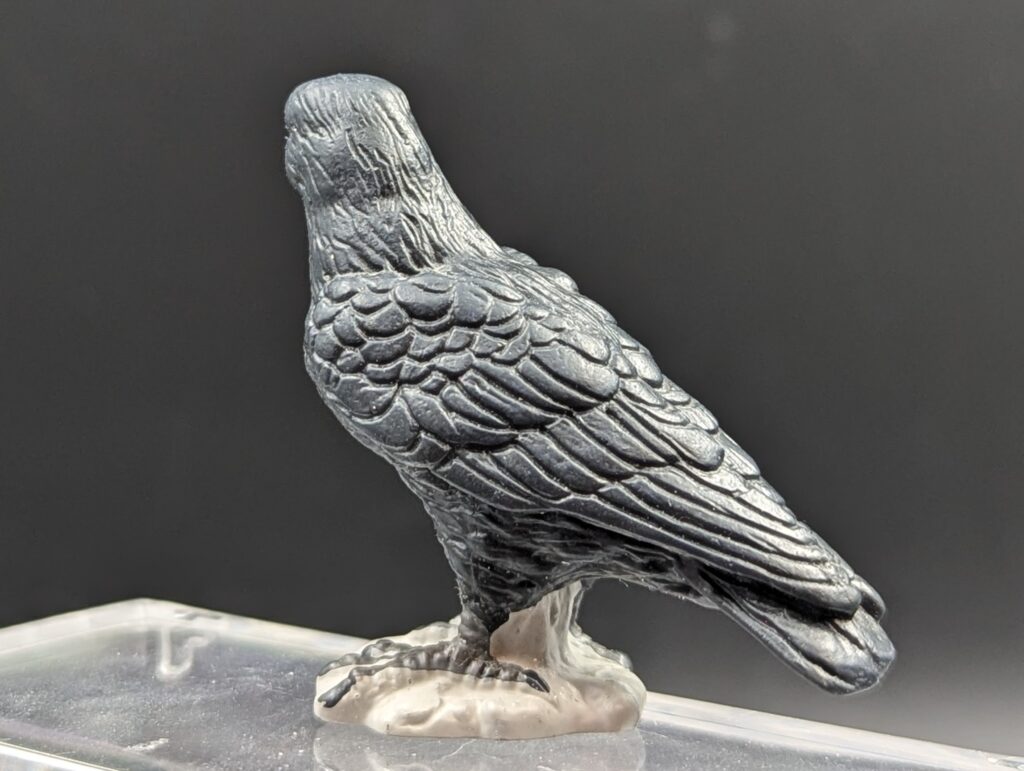
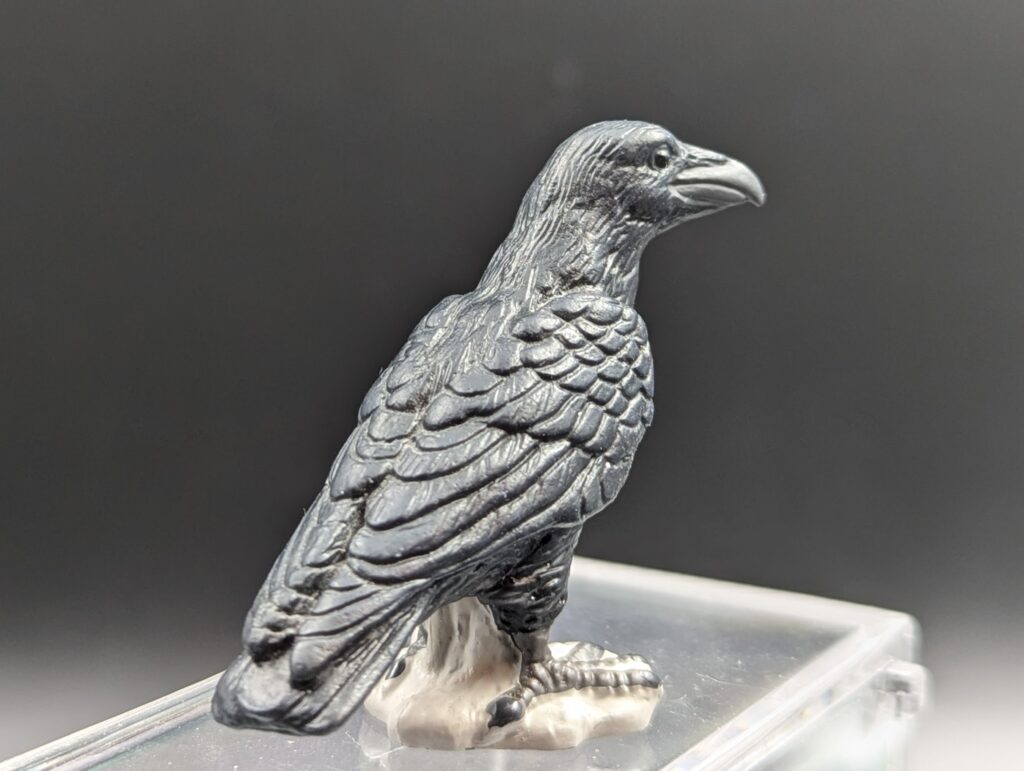
As befitting the famously black (usually) raven, the figure is overall painted in a solid black colour; it’s not quite glossy, but more of a satin finish. The feet stand out as dark grey, with long toes tipped in black claws; there is some muddling of the sculpt with the base. The feet do have the ringed scaly texture seen in exposed bird legs. The only other major colour differences are seen on the head. The eyes stand out as a glossy black; given the size, it’s hard to tell if the pupil is separate, or if they’re just painted orbs (I think so though). The bill also stands out–as seen in ravens, it is a dark grey (darker than the feet) and sculpted as quite deep. There is a noticeable curved hook present at the very tip of the upper beak–the bill overhang–that is present in ravens; this feature might aid with carrion, but is more likely to improve preening. Starting at the base of the upper beak along the top there is also a black triangular patch of black; on the real animals this would be a number of long, thin feathers, but on the figure is just kind of a mass with some faint striations. For the scale of the figure, this and the bill overhang is at least enough to clearly mark this as a raven and not a crow (it’s hard without seeing the tail in flight…)

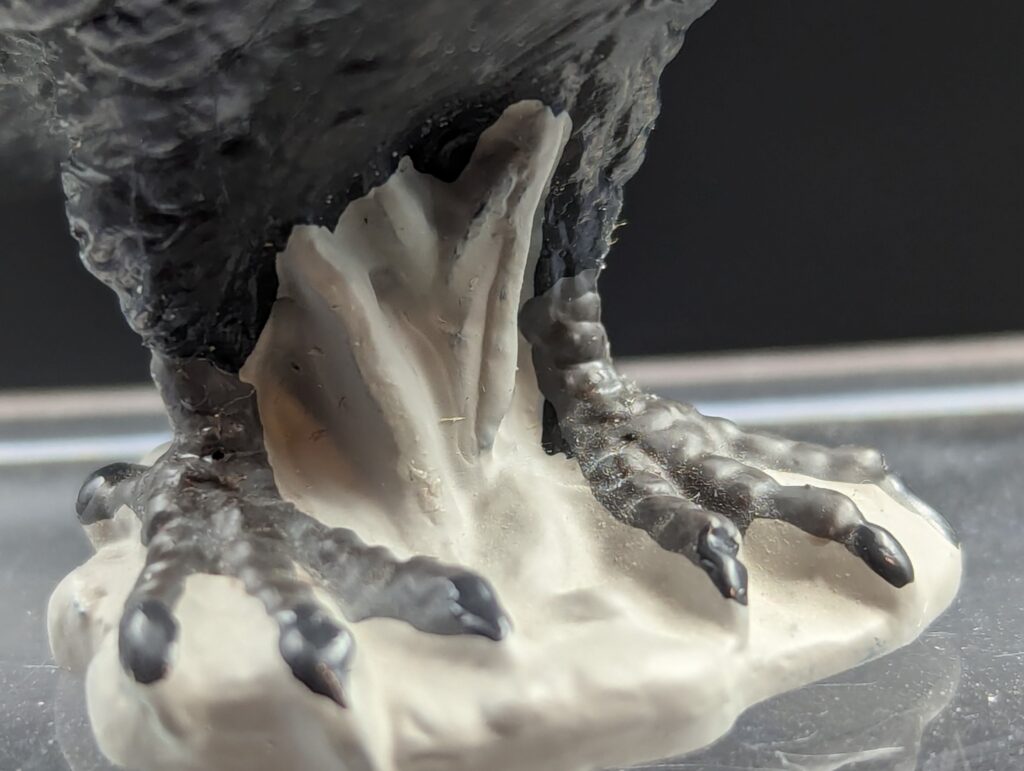
Overall, this figure has a lot going for it to represent these often misunderstood but fascinating birds; I’ll admit that birds aren’t my strong suit and this was hard! Anyway, given the age of the figure, I was at peak Schleich collecting when this came out in 2001, and at the time Schleich released all kinds of animals with a focus on collectors and quality. I think this raven does a really good job of this, and it’s a shame it was retired in 2004, never to be seen again (along with many of their other well made birds). It’s a bit of a surprise that the raven hasn’t been revisited again but at least Safari has one right now; I think the Schleich captures some of the head details a little better, but the Safari improved a bit on the feathering and the base (that earlier review expressed concern that the Safari figure might start to tip, but mine never has). Maybe they’ll update to capture more of the outspread wing and tail to really show off a raven (I’ve seen pictures of a Bullyland one but…nah). For bird fans, I highly recommend getting the Schleich raven if you can (it’s one of very few wildlife figures of the era that I still have) but I don’t know how easy that might be; Schlecih in 2001 was not nearly as widely available as it is now!
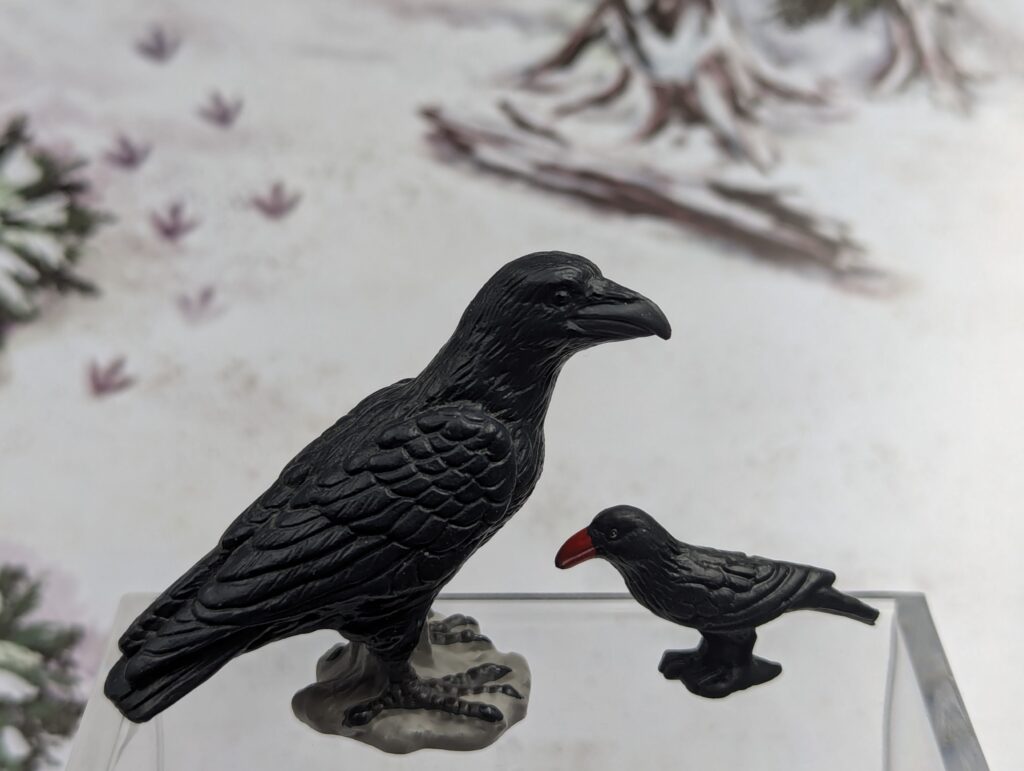

As a weird little aside, there was one other Schleich raven–from their mini line! It’s very small, and has a weirdly red bill, but was listed as rabe (German for raven) upon release. It’s also discontinued as of 2005, but I’m mostly mentioning it as it’s probably better suited for smaller dioramas than the bigger one I’ve discussed. Otherwise, it’s pretty simple and a fairly soft rubber. Cheap little impulse items back in the day…hard to find sometimes now!

Disclaimer: links to Ebay and Amazon on the AnimalToyBlog are affiliate links, so we make a small commission if you use them. Thanks for supporting us!




Seven of Nine would approve of this post.
Oooo an obscure Voyager reference! I like it!!!!
And this is a very nice raven, indeed. Better than expected.
I’d completely forgot about that! It’s been a long time.